What does the agro-lobby have to say about the air that you breathe? More than you think. The debate on air quality in Europe has turned into a brawl where the agricultural sector has knocked out emission standards for farms in the new air quality directive – and that has serious consequences for our health.
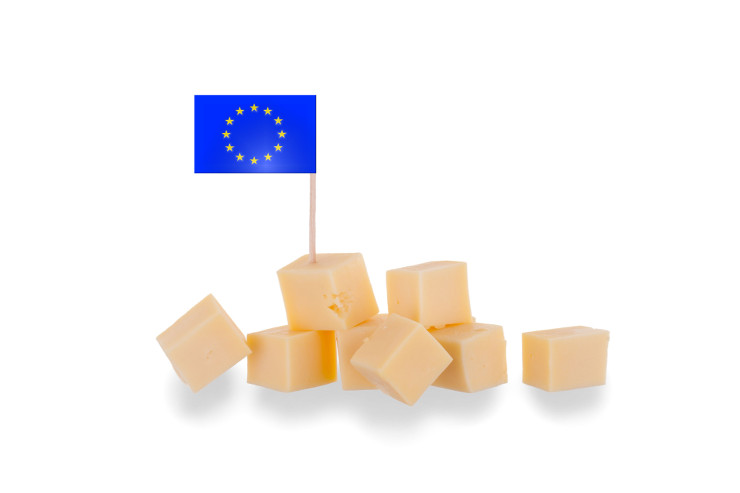
Image: Alamy
“We need to fight against lobbyists”, Slovenian Euro-commissioner Janez Potočnik stated resolutely at the beginning of 2013, which was labelled “the year of air quality” by the EU. He was addressing a Brussels in-crowd of Euro-parliamentarians, European ministers and civic organizations. Potočnik was militant concerning clean air. He knew the hard data from his own services all too well. “Air pollution is the number one environmental cause of premature death in the EU, responsible for ten times the toll of road traffic accidents”, wrote the environment department. In 2010 that amounted to 400,000 early deaths. Potočnik found that unacceptable: the air that European citizens breathe would have to be considerably cleaner by 2030.
At the end of 2013 he introduced revised standards for air pollutants substances: “national emission ceilings”. These was a directive that in addition to tightening limits for particulates (PM) and NOx (mono-nitrogen oxide), also set firm limits for methane and ammonia. Methane forms ozone, a source of smog, and is a potent greenhouse gas. Ammonia contributes to the formation of particulates and the accumulation of nitrogen in the environment. Forty per cent of all methane comes from dairy cow excrement, while another major source is oil production. Ninety per cent of ammonia is produced by livestock farming. The air-quality directive thus clearly required efforts from a sector that is known in the corridors of Brussels for its strong lobby: agriculture.
In December 2013, Potočnik’s directive went into the “black box”, the European decision-making process that for the most part is invisible to the outside world. When the directive emerged at the end of last year, methane had been completely knocked out. Ambitions for ammonia had slipped even further and were only a shadow of whatPotočnik had envisioned in 2013.
At the moment, the accord is finalised. Nearly all sectors had to do their share – industry, energy, consumers, shipping – but it’s a public secret that one was largely spared: the agricultural sector.
Just what happened inside of that black box? Down To Earth spoke to those involved, gained access to hundreds of documents via the Dutch Government Information Act, and now can reveal the role of the agro-lobby.
At the drawing table
What in Brussels is referred to as the “agro-lobby” is an organization called Copa-Cogeca. This group represents the interests of the European agriculture sector, including the LTO (Dutch Federation of Agriculture and Horticulture). They started in the design phase. What happened there is exemplary of how the fight for air quality in Europe is going. Moreover, it was there, early on in the process, that the directive suffered one of the most significant blows.
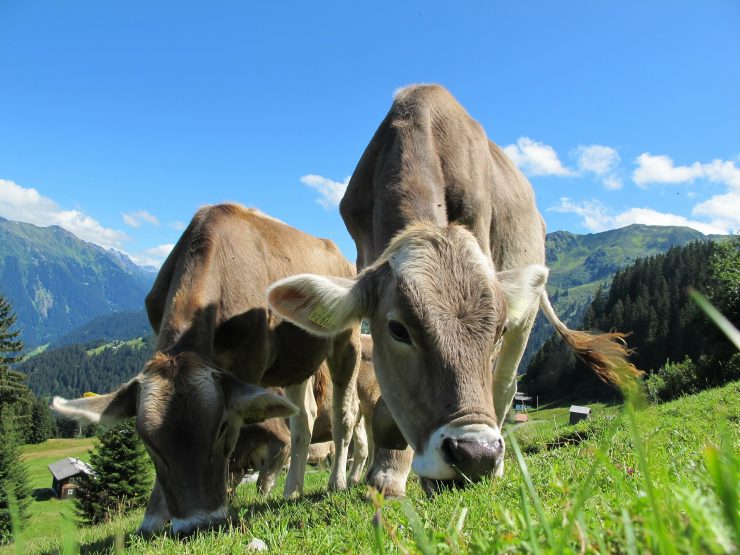
Austrian cows. Fourty percent of methane emissions are caused by livestock, especially cows. Image: Petapixel
In 2013, while Potočnik”s government employees were still at the drawing table figuring out the emission requirements for the member states, a letter arrived for Director-General Karl Falkenberg, the highest public official of the Ministry of the Environment. “Copa-Cogeca rejects as unrealistic and highly damaging for European agriculture possible Commission proposals”, wrote Copa-Cogeca on 27 November 2013.
Ammonia was the target. Copa-Cogeca had heard that the Commission was considering a 30 per cent reduction in ammonia emissions by 2025. This was to be the first time that Europe would set a firm limit for emissions for this substance. The lobby stated, “Our biggest concern is whether any proposals to further reduce ammonia emissions are realistic, achievable and cost effective all over the EU-28”. At the time Europe had just started negotiations on TTIP, a free trade agreement with the USA, something to which the letter seemed to refer. “Today, the EU is preparing for the opening of markets and removal of trade barriers in agriculture. In this context, more stringent production constraints in the form of stricter requirements on ammonia (…) emissions would be a threat to EU agriculture’s viability.”
Copa-Cogeca frontman Pekka Pesonen also sent a personal letter to Johannes Laitenberg, the head of the personal staff of former Commission president José Barroso. “The Commission has insisted on several occasions that agriculture’s potential to reduce ammonia emissions by 30-40 per cent can be achieved with ‘reasonably cheap measures’. We regret to highlight that Copa-Cogeca does not share this opinion.” That happened on 12 December – the week before a definite decision was to be made on the first resolution.
Furthermore, in Europe a directive that concerns the agricultural sector does not simply pass through the powerful agricultural department without a struggle. “The environment ministry was progressive, but at the agriculture department they wanted less pressure on the European agriculture sector”, stated Markus Amann of IIASA, an Austrian-based research institute that assisted the European environment staff with the calculations. “For ammonia, we had calculated a ceiling whereby farmers could largely earn back the necessary investments, cost-effective in theory. But following complaints from the agriculture department, behind the scenes that percentage was adjusted downward. ”
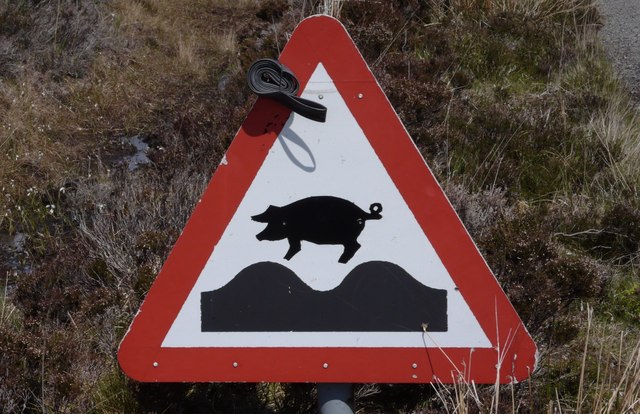
Pig farming causes a lot of methane emissions. Image: Anthony O’Neil Wikimedia CC SA BY
And quite a bit too. The original resolution, which remained within the walls of the EU Environment Ministry and which Down to Earth was able to obtain, calls for a 30 per cent reduction by 2025 and 34 per cent by the year 2030. But that is not what the European commission finally presented to the public on 18 December 2013. “To achieve the new air policy targets for 2030”, reads the resolution now, “The proposed NEC Directive requires ammonia reductions of 27 per cent.” The interim deadline of 2025 had disappeared from the resolution and the percentage for 2030 plunged by 7 per cent.
On paper this may not seem like much. But it meant that 275 kilo-tonnes more ammonia could be emitted annually by farming industry. As a comparison, the entire Dutch livestock industry emits 113 kilo-tonnes. And this was only the first strike.
Methane stranded at an early stage
Standards for methane, the other agricultural pollutant, were also under attack. Potočnik wanted to reduce methane emissions by one-third by 2030, as stated in the original Environment Ministry resolution. But a letter from Barroso’s staff, sent on 22 October 2013, attempted to stifle any ambitions for methane. The substance could already be addressed through the European climate policy; they wrote, “We think that the proposed methane emission ceiling and associated provisions should be deleted from the proposal on national emission ceilings.”
Methane is a greenhouse gas and therefore belongs in the climate policy. This argument used by Barroso’s staff appeared to come directly from the Brussels agro-lobby: “We support identification of synergies between air pollution and climate change policies”, Copa-Cogeca wrote in this period. “However, it would be disproportionate (…) to include methane into the scope of the NEC Directive.”

Thanks to their digestive systems, ruminants like cows and sheep are a significant source of methane.
Methane had suffered a blow but hadn’t yet been knocked out. Environment commissioner Potočnik threw his weight into the stride. According to those involved, he primarily ensured that the resolution that appeared at the end of 2013 still addressed methane. “Wherever you see ambitions coming through in this directive, you see Potočnik”, stated Euro-parliamentarian Bas Eickhout, who has been following the dossier for a long time.
Timmermans’ hit list
When a new European Commission took office in 2014 and Potočnik left, the directive scarcely had any allies left. The vice chair of the European commission, Frans Timmermans, had the job of reducing regulations and Potočniks’ resolution landed on what was referred to as Timmermans’ hit list. This seems to have occurred on the advice of another influential lobby in Brussels: BusinessEurope, the interest group of European industry, the other major emitter of methane. In a personal letter dated 25 November 2014, which was later leaked, BusinessEurope states: “In order to contribute to this exercise, we have carried out our own screening”. The directive for air quality also was on that list. BusinessEurope stated that they ”can therefore not be supported by us”. That was a striking choice of words for a lobby group that had no part in the decision. It was finally the EU Chair at the time, Latvia, that rescued the directive. But that didn’t mean that the resolution was safe.
Public Vote
Wednesday, 28 October 2015, was the moment of truth. It was the first time that the public could see that European agricultural interests had thrown their full weight into the fight. It was also the round that took place with an audience watching. The arena was the European Parliament plenary hall in Brussels. The parliamentarians were examining the air-quality directive and were to take their positions.
Amongst the broad array of subjects, a pattern became noticeable. The Dutch Liberal and Conservative party representatives spoke exclusively about emissions standards for agriculture. Methane was still included in the resolution and a 27 per cent reduction in ammonia was on the table. That would mean the end of family farming, read Annie Schrijer-Pierik – member of the Christian Democrats (CDA) and a pig farmer – from her notes. Jan Huitema, member of the Liberal party (VVD) and a dairy farmer, would have preferred methane and ammonia be removed from the resolution. Huitema had to abstain from the vote on ammonia. He couldn’t go against British Liberal faction member Catherine Bearder, who would have liked to see more ambition in this dossier. The Dutch conservatives voted against ammonia. And so, tightening up standards for ammonia, as the Environment Commission was still proposing, was voted down. Industrial methane, from oil production for example, remained in the package. But this time Huitema got his way: all methane from agriculture would be exempted.
The debate and the vote are again an example of how the agro-lobby works in Brussels’ decision-making process – not only in the public arena but also behind the scenes. The Party for the Animals (PvdD) received detailed voting recommendations that the lobbying organization Copa-Cogeca had emailed to all Euro-parliamentarians the day before the plenary debate. The parliamentarians were still recovering from another alarming letter they had received earlier from Copa-Cogeca frontman Pekka Pesonen. Pesonen wrote, “The only way to reach them [emission standards] is by reducing production in Europe and shift it to third countries.[…]This […]will impact the vast majority of European farms […].”

Norms for ammonia will have an effect on poultry farms too. Image: ben, Wikimedia, CC SA BY
New reduction figures
It was not only the agro-lobby that was hacking away at the emission standards: the environment ministers of the 28 member states – who together make up the European Environment Council – also played a part. Along with the Parliament, in 2015 the European Council also took a position on the resolution. Internal documents show that something notable took place in the run-up: the member states focused on the calculation methods used. And again, this mainly had consequences for agricultural emissions.
Many European member states found that the IIASA had made major miscalculations. The Netherlands claimed that the European Commission was using the wrong historical emission figures and that the ceilings for a number of substances were therefore too high…including ammonia. The countries decided to recalculate the reduction figures themselves.
The environment ministery in The Hague engaged the Netherlands Environmental Assessment Agency (PBL) for this job. A Dutch environment staff member in Brussels wrote prophetically to the PBL at the beginning of 2015: “If we soon publish figures that are not agreeable to agriculture and Economic Affairs, we can of course expect some hard lobbying.” But interestingly, one air polluter is ultimately missing from PBL’s recalculations: methane. This forebode what would happen next.
A salient feature is that the figures that were now being questioned had previously been worked out in consultation with the IIASA, the European Commission’s research institute. The Netherlands had also approved the EU’s calculations. According to Marcus Amann of the IIASA, a political game was played and the figures for emissions had been manipulated. “When we did the work there was intensive contact with all the member states on determining the correct data for drafting the European emission standards, with the Netherlands as well. We were in agreement on the principal features. But when negotiations started, the Netherlands contested the figures. The technical experts were sidelined.”
Ammonia cut in half, methane left out
In the summer of 2015, the member states submitted completely new reduction figures to Luxembourg, the country that in the meantime had taken over the EU chair. Behind the scenes it was then already clear that many member states had little interest in the European Commission’s ambitions for cleaner air. One Commission staff member found it quite shocking, according to the Dutch diplomats. Air quality was not very high up on their agenda, in particular for the East European countries. One of them – the name has been crossed out – appears to want to do absolutely nothing. The directive was viewed as a great threat to agriculture and there was a fear that emissions could not be reduced without “severe cutbacks in the agricultural sector”. And at the same time their ambition was to increase productivity in agriculture, one of the member states made known.
Whether it was a coincidence or not, the new calculations hit agricultural emissions the hardest. Ammonia, for which the reduction had already been cut from 34 to 27 per cent, was brought down to a meagre 18 per cent reduction by 2030. But methane was the hardest hit of all. The new environment ministers wanted to get rid of it entirely: “The Environment Council is agreed on removing methane.”
Short-lived climate pollutants
In the meantime the question remains: why did the PBL not recalculate methane in the new Dutch calculations? “Our calculation instruments are not suited to measuring methane”, stated Winand Smeets of the PBL, “there was not enough time and the urgency was lacking.” The most important explanation is in PBL’s preface to their report: “The emission reduction for methane is already provided in the international climate agreements and is therefore outside the scope of this analysis.” That sounds familiar: it’s the same excuse the agro lobby used.
That must be a thorn in the side of the Climate and Clean Air Coalition. This UN organization urges that “short-lived climate pollutants” such as methane must be tackled via both climate and air-quality measures. Moreover, at the Paris climate agreements, only twelve countries declared that they wanted to address these types of greenhouse gases – this is something that those involved could have known.
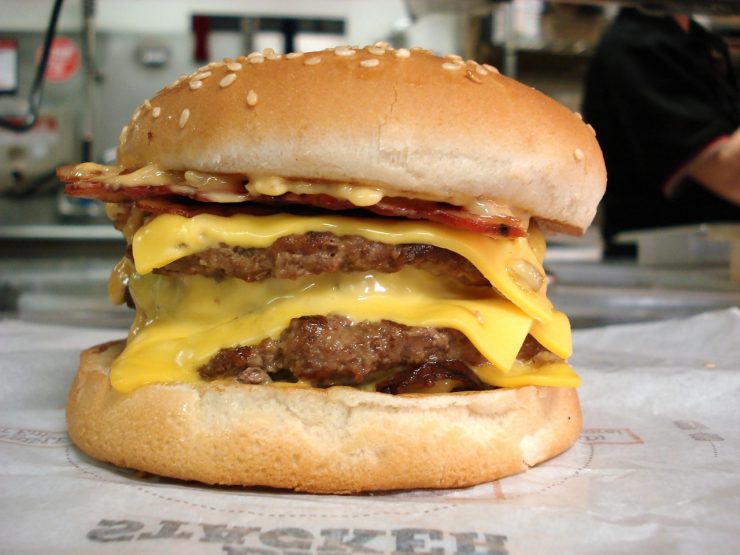
A decrease in meat consumption was not part of the calculations of the PBL. Image: pixabay
A decrease is taboo
Anne Knol of Milieudefensie [Friends of the Earth Netherlands] feels that PBL missed its chance. The institute mainly investigated how to tackle air pollution through technical measures. “Fewer animals, fewer cars, better public transport: such measures are completely missing in the report.” These things were discussed during the round table talks that the Ministry of Infrastructure and Environment held with industry, business interests, agriculture and civic organizations such as the Longfonds [a foundation for respiratory health], Milieudefensie and Natuur en Milieu [environmental organization]. A ministry staff member said in their defence during such a round table talk, “Volumemaatregelen moeten een plek krijgen in de politiek.” However, the subject is largely taboo there.
The reality is that European policy obstructs any decrease in livestock. Louise Duprez of the environmental lobby European Environmental Bureau stated, “The lobby leaves out the most significant argument: the elimination of milk quotas forced farms to keep more animals in order to continue to make a profit. Everything is focused on growth.” Dutch statistics seem to prove her right. In recent years, the Rabobank has extended billions in credit to dairy farms. LTO anticipates a growth rate of 10 per cent.
Kitchen tables
With alternatives lacking, the disaster scenarios of Copa-Cogeca and agriculture-minded politicians set the tone. “New emission standards will cause meat production to drop by 56 per cent”, said Evangelos Koumentakos of Copa-Cogeca bleakly in his Brussels office. “And that production is connected to the food industry, grain, grazing lands. The bigger picture is even more alarming.” According to Annie Schrijer-Pierik, a CDA Euro-parliamentarian, worries are mounting at farm kitchen tables. “You are forcing out family farms and with them also food production”, she argued in her office in the parliament building. “Those fine cows in the mountains of Austria will have to be kept indoors. You’re moving towards a much more intensive form of agriculture, with imported soya instead of grass. If food production disappears from Europe, it will be the same as with oil and gas: a motive for wars.”
Would emission limits indeed lead to the bankruptcy of European farmers? In March 2014 the PBL concluded in a European research study, “If Europeans cut their meat consumption by half, that would produce a great deal of environmental benefit; there would be less water and air pollution. The risk of cardiovascular disease would drop significantly. Europe would become an exporter of grain and would need to import 75 per cent less soya.” Moreover, 80 per cent of ammonia is emitted by 5 per cent of farms, claims Eickhout. “That has to do with multinationals – they don’t have any kitchen tables.”
Last round
Negotiations on the air-quality directive started their last round on 1 June. The Netherlands, currently the EU chair, wanted these to be concluded by 8 June, but the talks failed to lead to a conclusion in that time frame. In any case here was little hope left for ammonia and methane. Bas Eickhout was also present at the talks: “They can be taken out, as long as the total result is a 50 per cent cut in the number of early deaths in 2030. That is the minimum for the Euro-parliament.” This meant that methane could be removed and ambitions for ammonia would be further weakened. Even so, countries such as Hungary, Romania and Bulgaria were still opposed. Eickhout: “The problem is also that the big countries such as Germany, France and Italy aren’t pushing hard for this. The reason is the agro-lobby – they have held the debate hostage.”
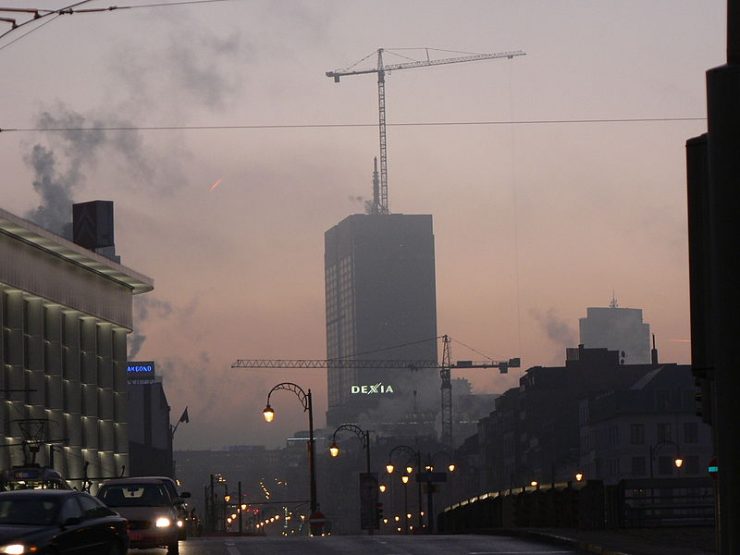
Brussels in smog. Image: Wikimedia, Belfius CC SA
Epidemiologist Bert Brunekreeft of Utrecht University fears that people and the environment will gain little from this directive. “Member states have the nasty habit of making the long-term goals attractive and then not to mention them anymore as the deadline approaches.” This assertion is supported by data on the air that the Euro-parliamentarians themselves breathe. In the same week, the European Commission held Brussels liable for exceeding limits on nitrogen dioxide. “While the city had ten years to prepare for compliance to the directive before implementation of the limits went into effect.”
On the 30th of June the Dutch Presidency proudly presented the completion of the NEC directive. ”With this directive we will combat air pollution”, stated Sharon Dijksma, Dutch minister of environment. In reality the directive no longer contains any of Potočniks militancy. The Commission and the Parliaments original ambitions were overruled by the member states united in the Council. They came to an agreement on 49,6 per cent reduction in premature deaths in 2030, methane was skipped form the directive and overall ambition levels for the remaining five pollutants were watered down. Finally member states are given the flexibility to average their emission reduction over three years. ”Making the limits much more difficult to enforce”, according to the EEB.
This is a translation by Iris Maher of this article.
This article is the result of investigative journalism project on the lobby aroudn the European air quality directive. This was a collaboration of Vincent Harmsen, Berna van Vilsteren and Sjors van Beek.
Down to Earth is the editorially independent magazine about environmental issues and the environmental movement, made possible by Friends of the Earth Netherlands. Independence is guaranteed by our editorial charter. Down to Earth funds investigative journalism on environmental subjects.


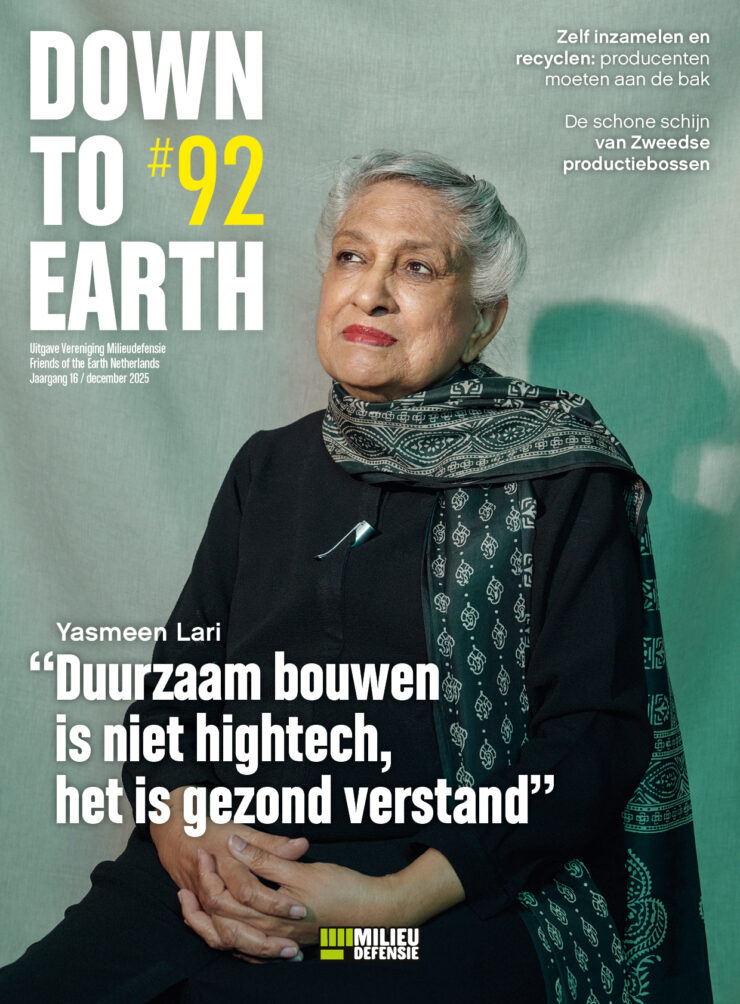
Recente reacties